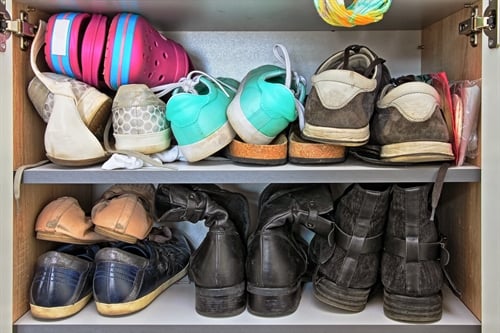I was looking at the shoe storage in our hall the other day and it occurred to me that it was a bit cluttered. I realised that there were several pairs of shoes in there that I haven’t worn for a couple of months – and I’m not likely to wear them again until autumn. I was a bit disappointed that I didn’t spot them when I went round the house in the spring looking for winter items to store!
I was going to put my out-of-season shoes in the attic – but then I remembered that we’ve got a bit of a mouse problem up there. I didn’t fancy facing autumn with trainers full of holes, so I’m taking them to our storage unit, which is climate controlled and pest free.
As with most areas of life, I like to do a decent job, so I did some research about storing shoes to see what the experts say. Here’s what I found.
Clean boots before storing them
Shoes and boots, no matter what they are made of, get dirty in day-to-day use. To avoid bringing pests, mould spores or noxious substances into your storage unit, clean your shoes before you store them. Make sure you dry them, too. Different types of footwear need cleaning in different ways, so check manufacturer’s instructions. Here’s Adidas’ thoughts on cleaning running shoes.
Sort your footwear
It makes sense to store your footwear in an organised way – so for example, you may wish to put shoes of the same colour together. Or you may wish to organise them by occasion or function. So put all your sports shoes in one container and all your office shoes in another container.
Use shoe trees
Shoe trees, whether wooden or plastic will keep your footwear in good shape by stretching out the leather and stops it from sagging and cracking. You can use boot jacks, or rolled up cardboard to keep the shanks of long boots from flopping over. This prevents creases in the ankles that can weaken your boots.
Box your shoes for storage
The boxes that come with shoes and trainers stack well and are sturdy enough for storing shoes. But you may prefer to use a specially designed shoe storage system. Be sure to label your boxes so you can quickly pick out the footwear you need.
Protect your footwear from damp
You may wish to use silica packets or some other moisture absorbing system in your shoe storage. This will mop up any residual moisture and save your shoes from changing humidity.
Insure your shoes
New footwear is expensive, so it’s worth insuring your stored shoes. Boots, shoes and trainers are all domestic goods so they are covered by a Store and Insure policy. Your personal property may not be automatically covered by insurance while it’s in your storage unit. Ask your storage company whether you are insured. You don’t have to take their insurance offering, either. Get a quote from Store and Insure so you can make an informed choice.


